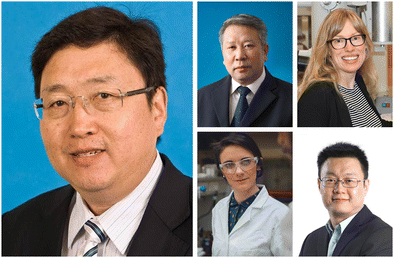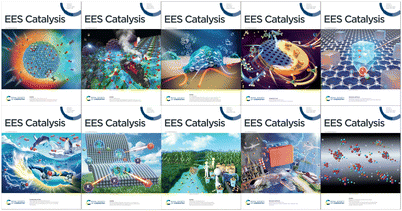 Open Access Article
Open Access ArticleCreative Commons Attribution 3.0 Unported Licence
The First Year of EES Catalysis
Shi-Zhang
Qiao†

School of Chemical Engineering and Advanced Materials, The University of Adelaide, Adelaide, SA 5005, Australia. E-mail: s.qiao@adelaide.edu.au
1. Introduction
As the Editor-in-Chief of this burgeoning Royal Society of Chemistry journal dedicated to catalysis, I am thrilled to welcome you to a platform that exemplifies the transformative spirit of open access in scientific research. Our journal stands as a testament to the Royal Society of Chemistry's pledge to remove the barrier of knowledge and accelerate scientific discovery.Catalysis, as a dynamic and interdisciplinary field, plays a pivotal role in addressing global challenges, ranging from sustainable energy to environmental remediation. The RSC's mission is to provide a space where groundbreaking catalysis research is not only widely spread but also easily accessible to researchers around the world. We understand that the journey to achieving 100% open access is not without challenges, and we are dedicated to overcoming them with innovative solutions. In the realm of catalysis, where collaboration and cross-disciplinary insights drive progress, openness acts as a catalyst for innovation. We aim to foster a community where ideas flow freely, transcending geographical and institutional boundaries. As we navigate the landscape of open science, we recognize the importance of addressing concerns related to article processing charges. The RSC's strategies include exploring novel partnerships and institutional agreements, and seeking support from funding agencies to ensure that the benefits of open access are realized without undue financial burden.
Moreover, our commitment extends beyond accessibility: it embraces the principles of transparency and integrity in scientific communication. Rigorous peer review, coupled with a dedication to transparent evaluation, ensures the reliability and quality of the research we publish. We invite authors, reviewers, and readers to join us on this exciting journey, where the exchange of knowledge fuels progress and where the doors to discovery are wide open. Together, let us shape the future of catalysis research through the transformative power of open access.
2. Our team
In EES catalysis, we have a professional and international editorial team consisting of 5 experts in catalysis research. We are grateful to have Associate Editors (in alphabetical order) Honggang Fu (Heilongjiang University, China), Susan Habas (National Renewable Energy Laboratory, USA), Rebecca Melen (Cardiff University, UK) and Zhichuan J. Xu (Nanyang Technological University, Singapore) (Fig. 1). The team has wide expertise and rich experience in diverse energy and environmental research, which contributes to the rigorous and fair peer review process of manuscripts. Among other recognitions, I am very happy to see three board members (Honggang Fu, Zhichuan J. Xu, and myself) being listed as Highly Cited Researchers (Clarivate).The Editorial Office's proficiency and constant support has ensured the smooth development of the journal. Their contributions are sometimes difficult to see because the absence of issues is often ever too easy to overlook. But we, and the authors, see them and their contributions very clearly. It is a privilege to work with Emma Eley (Executive Editor), Jon Ferrier (Deputy Editor), Sarah Whitbread (Editorial Production Manager), Alex Holiday (Editorial Assistant), Jamie Purcell (Assistant Editor), Alexander John (Assistant Editor), Emily Ellison (Assistant Editor), Jack Pitchers (Assistant Editor), Clare Fitzgerald (Assistant Editor), Lee Colwill (Publishing Assistant) and Neil Hammond (Publisher).
In addition, we are very honoured to have a list of esteemed colleagues serving as our advisory board members, who have provided important insights for presenting forward-looking and impactful contents in the journal. We’ve been grateful for the contributions of: Joel W. Ager III (Lawrence Berkeley National Laboratory, USA), Jong-Beom Baek (Ulsan National Institute of Science & Technology (UNIST), Korea), Alexis Bell (University of California, Berkeley, USA), Annemie Bogaerts (University of Antwerp, Belgium), Charles T. Campbell (University of Washington, USA), Sir Richard Catlow FRS (University College London, UK), Jingguang Chen (Columbia University, USA), Zhongwei Chen (University of Waterloo, Canada), Ib Chorkendorff (Technical University of Denmark, Denmark), Charles Dismukes (Rutgers University, USA), Shaojun Guo (Peking University, China), Qian He (National University of Singapore, Singapore), Douglas Macfarlane (Monash University, Australia), Ki Tae Nam (Seoul National University, Korea), Ungyu Paik (Hanyang University, Korea), Menny Shalom (Ben-Gurion University of the Negev, Israel), Licheng Sun (KTH Royal Institute of Technology, Sweden), Zhiyong Tang (National Center for Nanoscience and Technology CAS, China), David Tilley (University of Zurich, Switzerland), Xin Wang (City University of Hong Kong, Hong Kong) and Ye Wang (Xiamen University, China).
3. 2023 in review
Over the first year of EES catalysis, 68 published articles spanned a broad spectrum of energy and environmental catalysis research, delivering impact across a wide audience (Fig. 2). In published issues, the majority of articles (41) relate to electrocatalysis, followed by catalysis (14), photocatalysis (12), and hydrogen (1). Among them, there are 23 review articles and perspectives that present authoritative state-of-the-art accounts of the diverse research fields in catalysis.I would like to highlight some of the influential works that have provided significant insights into various catalytic processes and have been appreciated by the community so far. The team around Yi Xie published the inspiring article “Pit-embellished low-valent metal active sites customize CO2 photoreduction to methanol” (https://doi.org/10.1039/d2ey00029f). This work reports the improvement of product selectivity by precisely regulating the electronic structure of the catalyst surface, which facilitates the mechanistic understanding of customising CO2 photoreduction to liquid solar fuels. In another study, Frank E. Osterloh and colleagues exploited the Vibrating Kelvin Probe Surface Photovoltage Spectroscopy (VK-SPS) technique as a powerful tool to measure internal photo-voltage in semiconductor/liquid junctions and to identify efficient charge-selective contacts (https://doi.org/10.1039/d2ey00062h). This work elucidates the effect of surface treatments and charge-selective contacts on the photovoltage of photoelectrodes. In addition, the work “Descriptor-based identification of bimetallic-derived catalysts for selective activation of ethane with CO2” (https://doi.org/10.1039/d2ey00051b), contributed by Ping Liu and colleagues, revealed two general descriptors, the formation energy of alloy surfaces and the corresponding oxygen binding energy, which can be used to predict the thermodynamically favourable bimetallic-derived structures in CO2-assisted alkane activation. The findings provide mechanistic insights into selective bond cleavage in alkanes.
A lot of exciting studies focused on design and development of materials and technologies for various catalytic conversions. For example, the team around Huijun Zhao reported the work “High-efficiency electrosynthesis of urea over bacterial cellulose regulated Pd–Cu bimetallic catalyst” (https://doi.org/10.1039/d2ey00038e). The work brilliantly reported a Pd–Cu bimetallic electrocatalyst with dual active sites, which demonstrated facilitated C–N coupling reaction and a remarkable urea yield rate, surpassing almost all the currently reported urea synthesis electrocatalysts. As an important trend, Jingjie Wu and colleagues explored “Revealing the activity and selectivity of ppm level copper in gas diffusion electrodes towards CO and CO2 electroreduction” (https://doi.org/10.1039/d2ey00071g). This work answers the important question regarding the lowest-limit Cu loading in CO/CO2 electroreduction by revealing the activity and selectivity of ppm-level copper in gas diffusion electrodes. Finally, Sebastian C. Peter and colleagues introduced a rational catalyst design to facilitate the C–C coupling reaction in “Structural ordering enhances highly selective production of acetic acid from CO2 at ultra-low potential” (https://doi.org/10.1039/d2ey00081d), which is the first report of acetic acid production at ultra-low potential.
4. Conclusions
As reflected in the advancements in catalysis research within EES Catalysis over the past year, our commitment to open access has sparked a wave of innovation. The diverse groundbreaking contributions from worldwide researchers exemplify the collaborative spirit of catalysis science and transcend the conventional boundaries.Looking ahead, our focus remains steadfast on advancing globally impactful energy and environmental catalysis across all scientific disciplines including chemistry, materials science and engineering. In the coming year, we aspire to further streamline the publication process while maintaining the highest standards of quality, ensuring access to affordable, reliable and modern energy for all.
As we navigate the evolving landscape of scientific communication, our dedication to transparent peer review will continue to set a gold standard. We envision a future where the peer review process becomes even more engaging and constructive, fostering a sense of community among authors, reviewers, and readers.
In the next year, let us collectively propel our journal to new heights, embracing the challenges and opportunities in finding solutions to global challenges. Together, we will gather the pivotal catalysis research and inspire change around the world.
Footnote |
| † Editor-in-Chief, EES Catalysis. |
| This journal is © The Royal Society of Chemistry 2024 |


